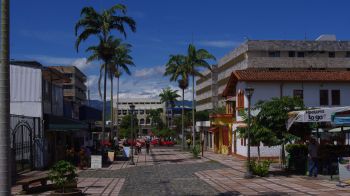Precolumbian period
9000 - First emigrants come to the area of present day Costa Rica.
The first aborigines become agriculturally and begin farming and settle down. As a result social hierarchy and division of labor develops and forms a new society.Trade relations and migrations create a regular exchange with the mesoamerican cultural complex and that of the northern section of South America (Chibcha cultures, Columbia).
Colonisation by the Spaniards
1502
Christoph Columbus, lands at the Caribbean coast near present Puerto Limon. He names the region Costa Rica (rich coast) because he had seen Indians carrying gold.
1522
The Spaniards try to conquer the land a second time coming from the pacific ocean. A first settling attempt on the peninsula Nicoya fails.
1563 - 1568
A campaign from Nicaragua (1563/64) toward the south is started to protect the territory and to pave the way for the Spanish settlers. Cartago is established (1564) as the first permanent settlement in the conquered area. After the first governor Juan Vazquez de Coronado dies in 1566, his successor Diego de Ribero pursues a violent reign by enforcing compulsory missionizing and enslavery of the Indians. The results were the depopulation of the region and the continual rebellions Talamanca and in the Boca del Toro area ,up to the end of in the colonial period which both were never permanently conquered by the Spaniards. 1568 Costa Rica, up to this point administered from Nicaragua, is subordinated directly to the government of Guatemala.
1570 - 1821
In the next two and a half centuries Costa Rica is a province of the Audiencia of Guatemala.
The way to independence
1821 - 1825
Mexico and Guatemala achieve independence. Now the search for a new political orientation begins for Costa Rica. After the civil war, the republicans win, beating the monarchists and so San José becomes the new capital. 1825 Costa Ricas first constitution is framed.
1848
Acknowledgement of the de facto existing independence of the country by an appropriate formal proclamation.
1855 - 1857
William Walker, an American adventurer, invades Nicaragua with a handful of pirates (Flibustier) and appointed himself as president of the country. His political opinions and goals, i.e. the establishment of slavery and creation of a Centralamerican vassal state dependent on the USA, induce Costa Rica to declare war against him 1856. Walker is defeated a first time in the area of the today's Santa Rosa national park, a second time shortly thereafter in the city Rivas (Nicaragua) and gives up then, cut off of its lines of communication at the Nicaragua lake, in 1857.
The liberal state
1871
A new liberal constitution shakes the power of the " coffee barons " and the middle class takes over and establish appropriate democratic principles. The infrastructure is improved and a railroad line is build from Limon to San Josè.The United Fruit company establishes itself here.
1917 - 1919
For a short period the dictator general Federico Tinoco takes over the power, but soon he is removed by a rebellion of the democratic movement.
1938
Due to economical difficulties, a strike and the fight against herbivore insects, the powerful United Fruit Company moves back from the Atlantic coast and settles down on a smaller scale on the Pacific coast. Unemployment and social difficulties are the results of the restructuring at the Atlantic coast.
1948
A civil war, caused by an attempt of election manipulation by the governing republican party of Rafael Angel Calderón Guardia, is decided by the opposition under José Figueres.
The new Costa Rica
1949
A constitutional reform is prepared, which aims at a further stabilization of the " bureaucratic " middle class and the democratic institutions. Likewise future selection manipulations should be prevented by dissolution of the army and prohibition of the re-election of a president.
1982
Costa Rica gets into financial troubles because of its welfare politics and the crisis of the 80's.
1986
Oscar Arias Sanchez (PLN) continues president Monges initiated course of neutrality against the Nicaragua-conflict. In 1987 he is given the Nobel peace prize.
1990 - 1998
The PLN and the Christian Democratic partv alternate with each other.
The election in 1998 returned the Christian Democrat candidate Miguel Angel Rodriguez whose primary goal is the fight against the countries spiralling inflation.
In 2002 and for the first time in the Costa Rica’s history has a President been returned after a second round of voting. After a very close deciding vote the Christian Democrat candidate Abel Pacheco was declared the winner. His main goal is the fight against corruption.
In 2006 the Christian Democrat party only received 3% of the vote after two former Presidents from the party, Calderon and Rodriguez were remanded in prison facing corruption charges. Oscar Arias from the Peoples party was elected President with a margin of 1% from his opponent Otton Solis; this followed a much-disputed election with talk of vote rigging.
In 2010 Costa Rica saw its first female President, Laura Chinchilla."

We would like to thank all our guests who have been travelling with us since 1994 in the most beautiful time of the year - their well-deserved holidays. When developing itineraries for groups and individual travelers, selecting our local service partners and caring about the well-being of our guests, we always focus on the highest possible quality standards. Since the founding of Amadeus Travel, we have been committed to sustainable tourism as the only long-term viable form of tourism, e.g. through our social commitment, visiting and supporting private and state nature reserves as well as the training of our team and experienced, fully licenced tour guides.











 Book Now
Book Now 





